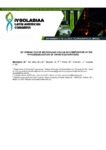Por favor, use este identificador para citar o enlazar este ítem:
http://www.alice.cnptia.embrapa.br/alice/handle/doc/1045552| Título: | Determination of microalgae cellular composition after phycoremediation of swine wastewaters. |
| Autor: | MICHELON, W.  DA SILVA, M. L. B.   MEZZARI, M. P.   PIROLLI, M.   PRANDINI, J.   SOARES, H. M.   |
| Año: | 2015 |
| Referencia: | In: LATIN AMERICAN CONGRESS, 4., 2015, Florianópolis. Anais... Florianópolis: UFSC, 2015. Disponível on line. SOLABIAA. |
| Descripción: | Phycoremediation of swine wastewaters has been widely reported as an attractive tertiary treatment system, that effectively removes the excessive nutrient loadswhilst offering a valuable source of feedstock biomass. Digestate from an upflow anaerobic sludge blanket (UASB, 6%v/v) and a nitrification reactor (NR; 50% v/v) were used as culturing media to microalgae. Experiments were carried out in lab scale photobioreactors (PBRs) using a consortia of Chlorella and Scenedesmus. Ammonia (44 to 90%) and phosphorus (77%) were efficiently removed from both effluents tested after 4 days. Microalgae biomass harvested from the UASB effluent showed 57, 34 and 1% of proteins, carbohydrates and lipids, respectively. Comparatively, the cellular composition of microalgae grown on NR effluent had lower protein (43%) but higher carbohydrate (42%) contents. Negligible difference in lipid fraction was observed independently of the effluents tested. The results suggest that the biomass harvested from phycoremediation of swine wastewaters can offer a valuable protein and carbohydrate feedstock for nutritional and biotechnological applications. |
| NAL Thesaurus: | microalgae |
| Palabras clave: | Carbohydrate Lipid Protein Phycoremediation |
| Tipo de Material: | Artigo em anais e proceedings |
| Acceso: | openAccess |
| Aparece en las colecciones: | Artigo em anais de congresso (CNPSA)  |
Ficheros en este ítem:
| Fichero | Descripción | Tamaño | Formato | |
|---|---|---|---|---|
| final7860.pdf | 328,61 kB | Adobe PDF |  Visualizar/Abrir |









